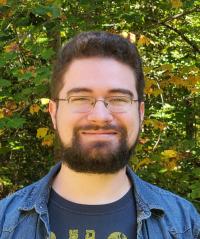Written By: Tiffany Whitfield
Keegan Sherman is the first graduate student from Old Dominion University to receive the Department of Energy's Science Graduate Student Research Program (SCGSR) supplemental award. Sherman, a Ph.D. student in the Department of Physics, was one of 52 students selected from across the country to receive this prestigious award. Sherman's research, being conducted at the Thomas Jefferson National Accelerator Facility or Jefferson Lab, in Nuclear Theory stood out amongst the other competitors.
"These graduate student awards help prepare new scientists for STEM careers that are vitally important to the DOE mission and the nation's economy," said Secretary of Energy Dan Brouillette. "We are proud of the accomplishments of these outstanding awardees and look forward to seeing what they achieve in the years to come. They represent the future leadership and innovation that will allow American science and engineering to excel in the 21st century."
"I applied for the Department of Energy's (DOE) Office of Science Graduate Student Research award because it provides a great opportunity to work alongside high ranking members of the physics community at a national DOE lab," said Sherman. "This award will allow me the ability to further my education in the field of nuclear physics, specifically exploring the theory of quantum chromodynamics (QCD)." Quantum chromodynamics describes the behavior of particles called quarks and gluons which bind together to form hadrons, for example the proton or neutron. Under the guidance of Dr. Raúl Briceño and Dr. Robert Edwards, Sherman will use powerful supercomputers to study this theory by employing a numerical tool called lattice QCD.
Dr. Raúl Briceño, ODU physics professor and Jefferson Lab researcher said "Keegan's project focuses on an exploratory idea to understand the nature of subatomic particles with the shortest lifetimes that have ever been observed in experiments." Most hadrons exist in unstable states with extraordinarily short lifetimes, making them exceptionally difficult to study. Hidden in the nature of these states lie the answers to some of the more puzzling questions pertaining to fundamental theory of the strong nuclear force. "As one can imagine, being able to resolve the composition and structure of an object that exists for such a short time is not a simple task," said Dr. Briceño. Keegan's research will help develop the mathematical foundation to paint a picture of these particles.
The goal of the SCGSR program is to prepare graduate students for science, technology, engineering, or mathematics (STEM) careers critically important to the mission areas of DOE Office of Science. The program plays an important role in sustaining a pipeline for a highly skilled scientific and technological workforce by providing new graduate students the opportunity to work on instruments available only at DOE national laboratories. Awardees are funded with travel and a generous $3000 per month stipend to work on their projects while living on-site at a DOE national laboratory.




